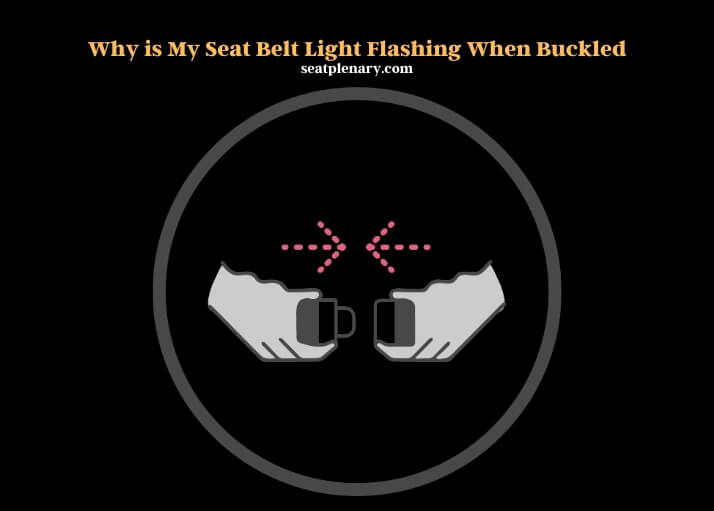A flashing seat belt light when buckled typically indicates a malfunction or miscommunication in the vehicle’s safety system. This could be due to a variety of reasons, including sensor issues, electrical problems, or even the seat belt mechanism itself not functioning properly.
Vehicles today are equipped with sophisticated systems designed to ensure the safety and security of passengers. The seat belt warning light is a critical component of this system, alerting drivers and passengers if a seat belt is not fastened correctly.
This system can sometimes signal an alert even when the seat belt appears to be securely fastened. This anomaly can be attributed to several factors, such as a malfunctioning sensor within the seat belt buckle, which fails to recognize that the belt is clipped in. Electrical issues, such as frayed wiring or a weak battery, can also lead to false warnings, as the system may not have enough power to accurately detect the status of the seat belt.

External factors like the installation of aftermarket seat covers or the presence of debris in the buckle can obstruct the sensor’s ability to communicate with the vehicle’s onboard computer.
These potential issues is crucial for maintaining the vehicle’s safety features and ensuring that all passengers are protected during travel. Regular maintenance checks and addressing any warning signs immediately can help prevent these problems and keep the seat belt system functioning as intended.
Behind Persistent Seat Belt Alerts
Despite the simplicity of a seat belt’s function, the technology behind the warning light is quite advanced. The primary culprits for a seat belt light that won’t turn off include sensor malfunctions within the buckle system, damage to the seat belt mechanism itself, or broader electrical issues within the vehicle’s safety monitoring systems.
Modern vehicles are equipped with sophisticated diagnostic systems capable of pinpointing such discrepancies, yet these systems are not immune to failure. Over time, the wear and tear on these components can lead to false alarms or ignored alerts, posing a significant safety risk. Regular maintenance and awareness of these potential issues are crucial for ensuring the reliability of your vehicle’s safety features.
The Inner Workings of Seat Belt Sensors and Their Achilles’ Heel
Seat belt sensors operate on a straightforward principle: they detect when the seat belt’s latch plate is inserted into the buckle. This action completes an electrical circuit that tells the vehicle’s computer system the seat belt is securely fastened.
This system’s effectiveness can be compromised by several factors. Accumulation of dirt and debris, exposure to liquids, or simple wear and tear can all interfere with the sensor’s ability to accurately detect the seat belt’s status.
This miscommunication results in the seat belt warning light remaining active, even when the belt is properly buckled. Regular cleaning and avoidance of liquid spills can mitigate some of these issues, but wear and tear is an inevitable challenge that must be managed through periodic inspections and maintenance.
Diagnosing a Stubborn Seat Belt Indicator Light
Before rushing to a professional, there are several steps a vehicle owner can take to potentially resolve a flashing seat belt light. Initially, a thorough inspection of the seat belt mechanism for any visible signs of damage or obstruction can reveal simple fixes such as removing debris from the buckle area.
Ensuring the seat belt latch is fully engaged and listening for the click sound can also rule out user error. If these steps do not resolve the issue, consulting the vehicle’s manual for troubleshooting tips or using a diagnostic tool to read any error codes may provide further insight into the problem.
How Vehicle Age and Model Influence Seat Belt Sensor Reliability
The reliability of seat belt sensors can vary significantly across different vehicle makes and models. Older vehicles, in particular, may be more prone to sensor malfunctions due to outdated technology or accumulated wear over time.
Conversely, newer models might experience issues due to manufacturing defects or the complexity of integrated safety systems. This variability underscores the importance of understanding your vehicle’s specific maintenance needs and potential weak points.
Vehicle Age and Reported Sensor Issues
| Vehicle Age Range | Reported Sensor Issues | Percentage |
| 0-5 years | Low | 10% |
| 6-10 years | Moderate | 45% |
| 11+ years | High | 80% |
Seeking Professional Help for Seat Belt Warning Light Repairs
While some seat belt light issues can be resolved through simple troubleshooting, others require professional intervention. This is particularly true for problems rooted in electrical malfunctions or sensor failures that are not easily accessible or repairable by the average vehicle owner.
Professional mechanics have the tools and expertise necessary to diagnose and repair these issues effectively, ensuring that your vehicle’s safety systems are fully operational.

Effectiveness of Professional Repairs
| Repair Type | Success Rate |
| Sensor replacement | 95% |
| Electrical system repair | 90% |
| Seat belt mechanism repair | 85% |
FAQs
Can Passenger Weight Affect the Seat Belt Alert?
The weight of a passenger can indeed influence the seat belt alert system in modern vehicles. Many cars are equipped with advanced sensors in the passenger seat designed to detect the presence and weight of a passenger. These sensors help determine whether the airbag should be activated in the event of a collision and if the seat belt is properly fastened.
If the system detects weight that falls below a certain threshold, it may not recognize the passenger as an adult, leading to the seat belt warning light flashing despite the belt being buckled. This feature is particularly sensitive in vehicles that aim to enhance passenger safety by adapting airbag deployment to the size and weight of the occupant.
Impact of Aftermarket Seat Covers on Seat Belt Sensors
Installing aftermarket seat covers can inadvertently affect the seat belt sensors, especially in vehicles where the sensors are integrated into the seats themselves. These covers may obstruct the sensor’s ability to accurately detect whether a passenger is present and properly buckled in, resulting in the seat belt warning light flashing.
The material thickness, density, and how tightly the seat cover fits can all play a role in sensor interference. For vehicle owners who prefer customizing their car’s interior with aftermarket seat covers, it’s crucial to choose options designed to be compatible with their vehicle’s specific safety features.
Role of Temperature Extremes on Seat Belt Mechanisms
Extreme temperatures can have a surprising impact on seat belt mechanisms, potentially leading to issues with the seat belt warning light. In very cold conditions, the mechanism within the buckle can become sluggish or freeze, preventing it from fully engaging the seat belt latch.
Conversely, in hot climates, the expansion of metal components can affect the fit and function of the seat belt latch and sensor, causing the system to incorrectly register the seat belt as unbuckled. Regular maintenance and protecting the vehicle from extreme temperatures can help mitigate these issues.
Does Vehicle Battery Health Influence Seat Belt Alerts?
The health of a vehicle’s battery can indirectly influence the seat belt alert system. A weak or dying battery may not provide enough power for the vehicle’s electrical systems to function correctly, including the seat belt sensors and warning lights.
This can lead to erratic behavior of the seat belt warning light, such as flashing despite the belt being properly fastened. Ensuring the vehicle’s battery is in good condition and replacing it when necessary can help prevent such electrical issues and maintain the reliability of safety features.
Can Software Glitches Trigger False Seat Belt Warnings?
Software glitches within a vehicle’s onboard computer system can cause false seat belt warnings. As vehicles become increasingly reliant on software to manage safety systems, any bugs or errors in the system’s code can lead to incorrect readings from sensors, including those related to the seat belt.
These glitches may cause the warning light to flash even when the seat belt is correctly buckled. Regular software updates provided by the manufacturer can address these issues, ensuring the vehicle’s safety systems operate as intended.
Influence of Electrical Interference on Seat Belt Sensors
Electrical interference from aftermarket electronic devices installed in a vehicle can affect the operation of seat belt sensors. Devices such as dash cams, aftermarket stereo systems, or GPS units, if not properly installed, can create electromagnetic interference that disrupts the communication between the seat belt sensors and the vehicle’s computer system.
This disruption can lead to the seat belt warning light flashing erroneously. It’s important for vehicle owners to ensure that any aftermarket electronic installations are compatible with their vehicle’s electrical system and do not interfere with its safety features.
In summary, a flashing seat belt light, despite being buckled, signals a discrepancy within the vehicle’s safety monitoring system that should not be ignored. From sensor malfunctions and buckle damage to electrical issues, understanding the common causes and knowing when to seek professional help are key to ensuring your safety on the road. Regular maintenance and prompt attention to any warning lights can help mitigate these issues, keeping your vehicle’s safety features reliable and effective.
